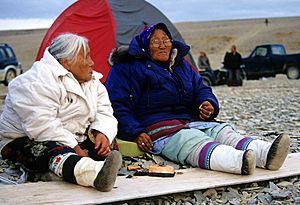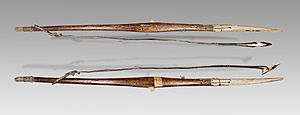Inuit cuisine facts for kids

Inuit cuisine is the traditional food eaten by the Inuit people, who live in the Arctic regions. This includes foods from places like Greenland and areas where Yup'ik people live. For a long time, the Inuit ate mostly foods they caught or gathered themselves. This meant a lot of meat from animals found nearby, like seals, whales, and caribou.
In the 1900s and 2000s, the Inuit diet started to change. Now, many Inuit also buy food from stores, similar to what people eat in Western countries. Even with these changes, traditional foods are still very important to Inuit identity. People travel using snowmobiles and dog sleds called qamutik. After a hunt, they often sing songs and do rituals to honor the animals.
Eating a diet mainly of meat helps the Inuit stay warm and strong in the cold Arctic climate. It also helps them stay healthy and fit.
Contents
What Inuit Eat
Inuit traditionally get their food from hunting, fishing, and gathering. Since plants don't grow easily in the Arctic, most of their diet comes from animals.
Hunted Meats
* Whale meat often comes from narwhals, beluga whales, and bowhead whales. A single bowhead whale can feed a whole community for almost a year! Hunters often go for younger whales because they are safer to hunt and their skin tastes better. * Ringed seals and bearded seals are very important. They make up a big part of an Inuit hunter's diet.
- Land Mammals: Animals like caribou, polar bears, and muskox are also hunted.
- Birds: Many kinds of birds and their eggs are eaten.
- Fish: Both saltwater and freshwater fish are caught. This includes fish like sculpin, Arctic cod, Arctic char, capelin, and lake trout.
Gathered Plants
Even though it's hard to grow plants in the Arctic, Inuit traditionally gather plants that grow naturally.
- Berries: Such as crowberry and cloudberry.
- Wild Plants: Like grasses and fireweed.
- Roots and Stems: This includes "mousefood," which are roots of tundra plants stored by small rodents in their burrows.
- Other Roots: Such as tuberous spring beauty and sweet vetch.
- Seaweed: Found along the coast.
Hunting Methods
Hunting is still important, but fewer young people are learning the traditional skills. This is partly because they are used to foods from the south. Also, hunting gear like snowmobiles, rifles, and sleds can be very expensive.
Hunting Seals
Inuit hunt different types of seals depending on the season.
- Ringed seals are hunted all year.
- Harp seals are mostly caught in summer.
- Seals make breathing holes in the ice with their teeth and claws. Hunters use these holes to find seals.
- A hunter sets up a special indicator at a breathing hole. When a seal comes up for air, the indicator moves, and the hunter uses a harpoon to catch the seal.
Hunting Walrus
Walrus are usually hunted in winter and spring. Hunting them in summer is much more dangerous.
- Walruses are too big for one person to hunt alone.
- Hunters work together. They approach quietly when the walrus's head is underwater.
- They then harpoon the walrus while its head is submerged. One hunter secures the harpoon to the ice.
Hunting Bowhead Whales
Bowhead whales are also caught with harpoons.
- Hunters actively chase the whale and follow it after harpooning.
- Sometimes, Inuit used a more patient method. They would harpoon the whale and then wait for the winds and currents to help bring it to shore.
Hunting Caribou
Caribou usually roam in small groups. Twice a year, large herds cross inland areas.
- Caribou have excellent senses of smell and hearing, so hunters must be very careful.
- Hunters often set up camp far away and wait for the caribou to come into view.
- There are many ways to catch caribou, including spearing them, forcing them into rivers, or stalking them quietly.
Fishing
Fish are caught by jigging through holes cut in the ice.
- Hunters cut a square hole in the ice.
- They use a fake fish lure on a line instead of a hook.
- They move the fake fish to make it look real. When live fish come close, the hunter spears them.
Nutrition and Health
The Arctic climate makes it hard to grow food. So, the traditional Inuit diet is high in fat and animal protein, and lower in carbohydrates.
- This high-fat diet provides lots of energy.
- Inuit get important Vitamins and minerals from animal sources.
- Vitamin A and vitamin D are found in the oils and livers of cold-water fish and mammals.
- Vitamin C comes from foods like caribou liver, kelp, muktuk, and seal brain. These foods are often eaten raw or frozen, which helps keep the vitamin C from being destroyed by cooking.
Eating Habits and Food Preparation
Inuit food is often eaten frozen, raw, or boiled. Very few spices are added, and ingredients are rarely mixed.
Some Traditional Foods
- Akutaq: This is a mix of berries and fat.
- Bannock: A type of flatbread.
- Igunaq: Fermented fish and meat, a way to preserve food.
- Labrador tea: A traditional drink.
- Suaasat: A traditional soup made from seal, whale, caribou, or seabirds.
Eating Customs
- Many hunters eat the food they catch right away, while it's still fresh. This helps keep them warm.
- One custom for fish is that it must be eaten raw at the fishing spot. It can only be cooked once you are a day's journey away.
- Inuit usually eat two main meals a day, but they often have many snacks in between.
- When eating, large pieces of meat and blubber are placed on the floor. Anyone in the house can cut off a piece.
- People eat only when they are hungry. Sometimes, a woman will shout "Ujuk!" (meaning "cooked meat") to let everyone in the camp know a meal is ready.
After a Hunt
- When a seal is brought home, hunters gather quickly to get their share first. They are the coldest and hungriest.
- The seal is cut in a special way. Hunters first eat pieces of liver or drink some warm seal blood. They might also mix fat and brain to eat with the meat.
- Women and children eat different parts of the seal after the hunters are done. They often eat the intestines first, then leftover liver, and finally the ribs and backbone. Any remaining meat is shared with the rest of the camp.
Sharing Food
Inuit are well-known for sharing food with their community.
- This tradition was first noted in 1910 when a young girl shared food with four families who had none.
- Sharing food is important for the well-being of the whole group.
- Younger couples often give food from their hunts to elders, especially their parents, as a sign of respect.
- Sharing food also helps families build strong bonds. Once you share food, you are in a "lifelong partnership."
- Inuit believe that food, especially hunted food, belongs to the whole community, not just one person. If you have food, it's meant for anyone who needs it.
Benefits and Beliefs of the Diet
Inuit believe their traditional diet makes them stronger, warmer, and full of energy.
Seal Blood and Raw Meat
- Drinking seal blood is seen as very healthy. It's believed to make human blood strong and replace nutrients.
- Inuit also believe that eating raw meat keeps them warmer and stronger, especially if eaten regularly.
- One Inuk named Oleetoa compared his diet (mixed with store-bought food) to his cousin Joanasee's diet (mostly raw Inuit food). Joanasee was found to be stronger, warmer, and more energetic.
Spiritual Beliefs
Inuit have strong spiritual beliefs about hunting, cooking, and eating.
- They believe there's a special connection between animals and humans.
- They also believe that mixing animal and human blood in the body creates a healthy person.
- The choice of diet is linked to the relationship between the body, soul, life, and health.
Hunting Beliefs
- Inuit believe that seals and hunters have an agreement. The hunter can catch the seal to feed their family, and the seal agrees to become part of the Inuit people.
- If hunters don't follow the traditions passed down by their ancestors, they believe the animals will disappear and stop reproducing.
- When a seal dies, it's offered a drink of fresh water. This shows respect and thanks for its sacrifice. This offering also pleases the spirit Sedna, who controls the sea animals, to ensure there will always be food.
Healing Beliefs
- Some Inuit believe that a lack of traditional foods, especially seal meat, can cause sickness.
- There are stories of people feeling better very quickly after eating seal meat and blood, believing it was the traditional food that healed them.
Images for kids
See also
 In Spanish: Dieta inuit para niños
In Spanish: Dieta inuit para niños




